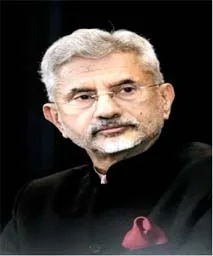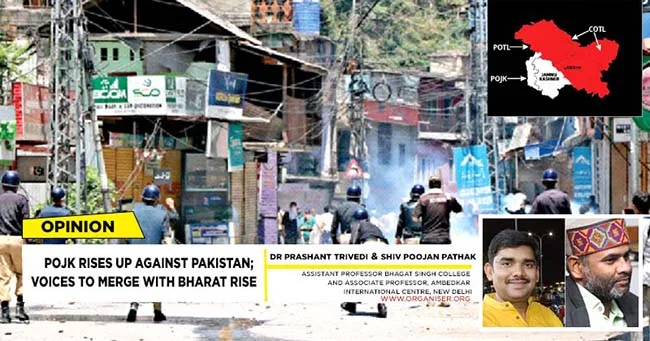The ongoing protests in Muzaffarabad, a major city of Pakistan occupied Jammu- Kashmir, have become a sort of resistance and assertion of local people against Pakistani rule, which is responsible for their economic exploitation and cultural suppression. These protests underline the illegitimacy of Pakistan’s control over PoJK. Protestors in the number of thousands are raising the slogan Ham Ko Chahiye Azadi (We want Freedom from Pakistan). Indian flags were also visible in many places. Till now, more than 70 people being seriously injured and various missing reported in Muzaffarabad, the actual number may be much higher, as Pakistan is using guns and shots to silence the voice of the people.
Suffocating Dissent
This is not a new phenomenon. Rather, it is just one glimpse of the ongoing anti-Pakistan sentiments throughout the entire occupied Jammu–Kashmir and Ladakh region, from Hunza, Skardu and Nagar to Mirpur- Muzaffarabad over the years. There have been continuous movements, protests against Pakistani brutality for years. From 2023 onwards, there have been continuous serious protests going on throughout Gilgit-Baltistan, which intensified from January, 2024. Pakistan always responds with a heavy-handed approach like life imprisonment and opening the fire on civilians to stifle dissent and maintain its grip over the region. In May 2022, local people became aware that Pakistan was secretly planning to lease out the mineral-rich region of Upper Hunza to China. In opposition to this, widespread protests erupted. Leaders of this protest Shaukat Kashmiri, Mumtaz Khan with others were imprisoned and tortured by the Pakistan Government. Even ‘Tourism Minister and Health Minister’ of Gilgit-Baltistan, were publicly beaten up by the Pakistani Army during this rally. In October 2020, thousands of people blocked the Karakoram Highway demanding the release of Baba Jan and 13 activists. Slogans like Pakistani Sena Murdabad (Down with the Pakistan Army)”, ye jo dahshatgardi hai ..iske pichhe wardi hai… (the uniform is behind this fear and harassment) were very frequent. In order to suppress dissent and instil fear, Pakistan forces opened fire, resulting in deaths of many leaders such as Zakir Hussain, Ghazi Anwar and Ashiq Mir.
Resorting to Life Imprisonment
Since the 1990s, the people of this region have begun to acknowledge that they are citizens of Jammu–Kashmir and Pakistan is exploiting them. Despite the fear for their lives, the common people started opposing the Chinese-Pakistani exploitation and oppression. Due to this opposition, people like Nawaz Naji, Baba Jan, Abdul Hamid Khan and many others are being imprisoned for life. Even in small towns like Aliabad and Murtijabad, significant protests took place in September-October 2021. They are expressing their grievances on every platform available but the Pakistani media ignores these protests. Pakistan, with its expertise in fabricating lies, tries to confuse the people here, sometimes by invoking Islam and sometimes by creating new provinces. Several reasons contribute to the intensity and depth of resistances: First, the people of Gilgit-Baltistan and Mirpur-Muzaffarabad are becoming aware of the systematic exploitation they face at the hands of Pakistan and China. Second, they are familiar with Pakistan’s failing economy and collapsing political system. Third, since 2014, the Indian Government has shown considerable readiness to support these brothers and sisters openly. Moreover, Bharat’s economic and military strength has instilled confidence among the people here. Fourth, China continues to grab land of local people with the help of Pakistan’s military as they arrive at night, destroying homes and farms of locals and handing over the land to China is common practice.
Illegally Occupied Territories
According to the Indian Independence Act of 1947, Princely States were supposed to join either India or Pakistan based on their geographical proximity. In this situation, the Maharaja of Jammu –Kashmir had to take decisions about accession. On the other hand, due to friendship with Sheikh Abdullah, Pt Nehru was adamant that the representative of Jammu and Kashmir should be in the hands of Sheikh Abdullah instead of Hari Singh. The British Government was making every effort to Maharaja Hari Singh to accede to Pakistan. Mountbatten and Lord Ismay advised Maharaja to immediately decide in favour of Pakistan. During this time, lawlessness was increasing along the border. Prime Minister of Jammu and Kashmir, Mehr Chand Mahajan, and Home Minister of India, Sardar Patel believed that the Maharaja should immediately decide on accession to India. On September 27, news of preparations for invasion by Pakistan for the first time was received. Pandit Nehru was still adamant that without handing over power to Sheikh Abdullah, a solution to the problem of Jammu and Kashmir could not be found. This created tension, and Pakistani invaders found an opportunity to enter the territory. On October 15, under the direction of the Pakistani Army, attackers disguised as tribesmen began advancing towards Jammu and Kashmir. On October 22, Muzaffarabad was occupied by them.
The Maharaja requested assistance from the Indian Government.
GuruJi’s Role in Accession
Meanwhile, on October 18, Guruji, the then Sarsanghchalak of Rashtriya Swayamsevak Sangh, met Maharaja Hari Singh. This meeting helped the Maharaja in deciding to accede to India. VP Menon arrived in Srinagar on October 25 to assess the situation, and on October 26, 1947, Maharaja Hari Singh, whose title was Shriman Indra Mahendra Rajarajeshwar Maharajadhiraj, (King of Jammu and Kashmir, and other countries including Tibet), signed the Instrument of Accession. Within two months of accession, Pakistan illegally occupied Mangla, Alibeg, Mirpur, Bhimber, Deva and Batala regions, Rajouri , and the entire region of Naushera, Jhangar, and Kotli.

“Today there are certain ferments happening in POJK and its analysis is very complex but definitely I have no doubt in my own mind that someone living in Jammu and Kashmir and seeing how people are progressing nowadays. They know the sense of being under occupation and being discriminated or treated badly.” — S Jaishankar, External Affairs Minister of India
As for Gilgit-Baltistan, under the Indian Independence Act of 1947, the paramountcy of the British Government ended. Britishers handed over Gilgit-Baltistan to Maharaja Hari Singh, but responsibility for security was still with the Gilgit Scouts, which was under the leadership of Major W Brown. He along with the Muslim officers and soldiers of the Jammu–Kashmir Army committed treason. They reached Gilgit and took Governor Ghansara Singh hostage at his residence. Muslim officers of the Jammu and Kashmir Police also betrayed at this time and joined Major Brown. Brigadier Ghansara Singh had to surrender. Hindu and Sikh members of the Army were massacred. At the end of 1948, a ceasefire was declared by the United Nations, as a result of which Gilgit-Baltistan remained under the illegal control of Pakistan.
Changing Demography
The primary objective of Pakistan’s administration is to exploit the human and material resources of the region. Therefore, it aims to maintain its dominance over this territory by any means. Pakistan is changing demography by settling Sunni Muslims from Punjab and the North-West Frontier Province in the region. The people of Pakistan-occupied Jammu and Kashmir and Ladakh live a colonial life, as scholars say it is the ‘last colony of the world’. People are not allowed to protest in Mirpur-Muzaffarabad or Gilgit-Baltistan. Abductions, killings, imprisonments and forced land seizures by Pakistani security forces are very common occurrences. Most administrative and military positions in Pakistan-occupied Jammu and Kashmir and Ladakh are held by Punjabi Pakistani, sent from Pakistan. Pakistan is destroying local languages, scripts, dialects, forests, festivals and trying to detach people from their roots.
Pakistan receives a large sum of foreign currency from Mirpur-Muzaffarabad and Gilgit-Baltistan. A significant amount of foreign currency is sent by Mirpuri migrants, mostly residing in the UK. Similarly, the Gilgit-Baltistan region generates substantial income from tourism. The reality is that Pakistan does not have its own tourism industry. Rather, 70 per cent of the international tourists visiting Pakistan go to Gilgit-Baltistan. All this income is kept under Pakistan’s control. The Mirpur-Muzaffarabad region is rich in precious metals and stones and Gilgit-Baltistan has 1,480 gold mines. Pakistan exports these metals to the global market without any liability to people. Local people are restricted from entering these mines as they are designated “no zone areas.” However, Chinese companies are extracting minerals by building tunnels and conducting internal explosions.
For the past 30 years, Pakistan has been waging a proxy war against India through terrorism from this area. Almost all active terrorist groups have their training centres in Mirpur-Muzaffarabad area with the support of Pakistan. Pakistan harbours terrorists and uses Sunni extremism to persecute people of other sects. The best example of this tactic is Shia-Sunni conflict in Gilgit-Baltistan.
Sharda Peeth Mandir in Ruins
Located just 17 miles from the LOC, at the confluence of the Kishanganga and Madhumati rivers, the Sharda Peeth temple has always been a revered site in the Sanatan tradition as the abode of the Goddess of Knowledge. In Sharda village, situated in Pakistan-occupied Jammu and Kashmir, only ruins remain of the temple.
Bharat’s Response
India has always maintained that the entire region of Jammu and Kashmir is an integral part of its territory. The present Government is sensitive and proactive regarding this Pakistan-occupied Jammu–Kashmir and Ladakh. The Indian Parliament unanimously passed a resolution on February 22, 1994, declaring that the State of Jammu and Kashmir is an integral part of India and will remain so. Any attempts to separate it from the rest of India will be opposed by all necessary means. Almost all important Ministers of the Modi Government have expressed their unambiguous thoughts on Pakistan-occupied Jammu–Kashmir and Ladakh. The most official statement was made by Home Minister Amit Shah on August 6, 2019, in Parliament. In Shah’s words, “When I talk about
Jammu –Kashmir, it includes Pakistan-occupied Jammu–Kashmir and Aksai Chin. We are ready to sacrifice our lives for this region.” Defence Minister Rajnath Singh and Foreign Minister Dr S Jaishankar have also made similar statements on Pakistan-occupied Jammu–Kashmir several times, indicating that India is firmly committed to our land and our people of this region. Indeed, the future of this region will depend on India’s strength and evolving dynamics of international politics.



















Comments